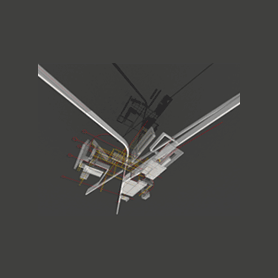Mario Cipresso
Architect and Founder of Studio Shift and Death by Architecture, and Educator at University of Southern California School of Architecture
Primary design concentration:
Architecture
Most preferred tool for designing:
Loose hand-sketching and MicroStation TriForma
1. How and why did you choose to become a designer?
I wish I had a romantic story about my calling as a designer but it really was an evolutionary process beginning with some required, mundane mechanical drafting classes in high school where I really discovered I had a natural ability for deconstructing and reconstructing objects both mentally and physically. Through some additional architecture courses in high school and subsequently college, I really became interested in the possibilities inherent in the physical representation and eventual realization of an abstract concept that has its genesis outside of the conventional understanding of architecture.
After some extensive therapy sessions, I might be able to attribute my tendency towards architecture to all the construction toys I was given as a child.
2. Challenges you encounter as a designer and how do you deal with them?
I believe we all deal with the same issues regardless of our professions and oftentimes the most difficult challenges are related to simply dealing with the many types of personalities that exist in the world. These challenges more often than not result in lasting friendships but you have to manage to find common ground and respect what everyone brings to the table. We all have expertise in something.
As an architect, I have to say that it just takes an amazing amount of energy to build anything in the world today, regardless of scope and scale. It’s the generally inefficient bureaucratic process required by the various jurisdictions that can stall virtually any project and you just have to be determined and keep pushing, it will happen.
3. Your definition of an “elegant solution,” that is, good design?
For me an elegant solution is one that operates on multiple conceptual levels while still satisfying and even surpassing a specific performance criterion. Elegance is more than simplicity, it’s really a nod to refinement which really only comes through thoughtful iteration and intense rigor.
4. From skills to values, what makes a designer successful?
Awareness in a global sense makes a designer successful. This refers to being abreast of developments not only in your specific field, but also in the broad range of parallel fields from which you can draw inspiration. This includes being involved in and aware of the methods and processes dominating the discourse in relevant educational institutions. It means being a well-traveled designer that earnestly tries to be personally and directly conscious of urban, political, social, economic conditions affecting the world at large.
Most importantly, you have to care about what you do. And you need to believe in what it is you do especially in the face of adversity and resistance. You must have the will to fight for your ideas.
5. How do you stay motivated and grow personally and professionally as a designer?
I generally don’t have an issue with motivation and maybe it’s because I’m at such a critical yet early point in my career when you consider the big picture. Perhaps I’m dealing a bit more with frustration at this moment but I believe it stems from a hunger for larger, more meaningful work. It’s the desire to make that leap in scale that is urging me forward.
I do find that teaching is a valuable mechanism for growth and motivation. You genuinely have the opportunity to explore a multitude of new ideas each day while maintaining involvement in new and exciting developments in technology, education, etc.
6. For those aspiring to become a designer, whatever the discipline, what is your advice?
Don’t go half-hearted into a design career and expect to find great success. Because design is generally subjective, you have to be prepared to convincingly sell your knowledge, expertise and finally your design to someone who may not agree with your opinion. Having conviction in your ability to make decisions and being able to authentically express those ideas is vital and that comes when your work is not just a job, it’s your life. When you can immerse yourself at that level, the rewards come in ways you could not have imagined.
7. What is your quest in design?
As idealistic as this may sound, my current desire is to really contribute meaningful and thoughtful projects to the international community over various scales and programs. I have developed a great interest in urban planning through intense involvement in several large-scale projects and it’s an area of design that connects nicely with architecture. Regardless of the type of work, I hope to be able to continually approach each new project with an eye towards invention and innovation, always considering a broad range of ideas.
Previous: Ruth Schmidt | Next: James David Morgan

Support Design Feast via Patreon
This self-made project and its related efforts constitute a gracious obsession. The intention is to give a wholehearted and timely serving—as much as possible—of creative culture. If you gain a level of motivation, knowledge, even delight, from the hundreds of interviews plus write-ups here at Design Feast, and are able to contribute, please become a Patron with a recurring monthly donation. Thank you for your consideration!
Stay healthy and keep creating throughout the year!
Wishing you much success,
Nate Burgos, Content Creator & Publisher
Comments
There are no comments yet.
Leave Your Comment